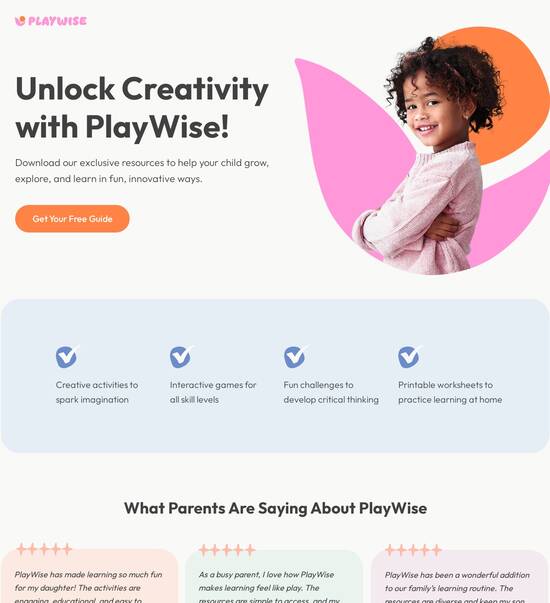
Blog page template for School Management
Use TemplateAbout template
Discover our vast library and find your perfect blog page template for School Management. See how easy it is to improve your conversions with Instapage!
Recommended templates

Easy to build without coding
With the intuitive drag-and-drop builder, anyone on your team can create high-converting pages without any knowledge of code or design. Make enhancements to your landing page with custom widgets using Javascript, HTML/CSS, or third-party scripts.

Multiple layouts for any industry and goal
Select from 500+ landing page layouts built to boost conversions across industry-specific scenarios. Customize them by adjusting fonts, adding images, and generating on-brand content with the AI assistant. Quickly scale with Instablocks® and Global Blocks that you can save, reuse, and update globally.

Loads fast and looks polished on any device
Every template is responsive, which means they present professionally on any device and load blazingly fast with our Thor Render Engine. You can also power them up with Google AMP technology to deliver an unparalleled mobile experience and drive higher conversions.

Robust analytics & experimentation
Get real-time updates and reporting across all your devices, showing the number of visitors, conversions, cost-per-visitor, and cost-per-lead. Launch AI-powered experiments, run A/B tests, and use heatmaps to analyze user behavior, then optimize your landing page to maximize conversions.







Easy to build without coding
With the intuitive drag-and-drop builder, anyone on your team can create high-converting pages without any knowledge of code or design. Make enhancements to your landing page with custom widgets using Javascript, HTML/CSS, or third-party scripts.
Multiple layouts for any industry and goal
Select from 500+ landing page layouts built to boost conversions across industry-specific scenarios. Customize them by adjusting fonts, adding images, and generating on-brand content with the AI assistant. Quickly scale with Instablocks® and Global Blocks that you can save, reuse, and update globally.
Loads fast and looks polished on any device
Every template is responsive, which means they present professionally on any device and load blazingly fast with our Thor Render Engine.
Robust analytics & experimentation
Get real-time updates and reporting across all your devices, showing the number of visitors, conversions, cost-per-visitor, and cost-per-lead. Launch AI-powered experiments, run A/B tests, and use heatmaps to analyze user behavior, then optimize your landing page to maximize conversions.
All the features you need to build blog template for students
Explore more featuresLearn how to build school management system website templates
Frequently asked questions about school management system template
Leading the way in building high-performing landing pages





School blogs: Your ultimate how-to guide
Landing pages are a cornerstone of successful digital marketing campaigns. Instapage's sophisticated yet user-friendly platform enables marketers to design and deploy landing pages that not only capture leads but also optimize conversions, thereby maximizing ROI. This guide walks you through the essentials of creating effective landing pages using Instapage, addressing both best practices and practical tips.
Understanding the components of high-converting landing pages
Creating effective landing pages begins with understanding key components that contribute to high conversion rates. Instapage offers over 100 conversion-focused templates that you can customize for your unique audience. These components include compelling headlines, persuasive call-to-action (CTA) buttons, and strategically placed lead generation forms. Each element should work together to guide the visitor towards your objective.
- Compelling headlines: Headlines should be succinct and captivating to grab attention immediately.
- Persuasive CTAs: Ensure that your CTAs are action-oriented, using verbs that encourage visitors to take action.
- Lead generation forms: Position forms strategically to capture leads without overwhelming the visitor.
Step 1: Select a template and customize your layout
The first step in creating your landing page on Instapage is selecting a suitable template from the extensive gallery. Use Instablocks, which are pre-designed sections, to customize your page layout quickly. Tailor the colors, fonts, and images to fit your brand identity.
Step 2: Optimize for conversions with experimentation
To ensure your landing pages perform optimally, leverage built-in experimentation features. Conduct A/B tests to analyze various versions of your page and determine which elements foster better engagement and conversions. This data-driven approach helps refine your content and identify what resonates best with your audience.
- A/B testing different headlines: Test how varied headlines impact user engagement rates.
- Color variations for CTAs: Experiment with different colors to see which attracts the most clicks.
- Form length: Analyze how the number of fields affects form submissions.
Step 3: Personalize content for your target audience
Utilizing personalization tools, like dynamic text replacement, can significantly enhance user experience by delivering tailored content. Instapage allows you to align specific ads with targeted landing pages and track audience-level metrics, ensuring that your marketing efforts are both personalized and effective.
- Dynamic content delivery: Customize messages based on user behavior and demographics.
- AdMap integration: Align ads to specific landing pages for cohesive messaging.
- Audience tracking: Gain insights into user interaction to refine future campaigns.
In summary, following these steps enables marketers to use Instapage effectively, facilitating landing page creation that drives results. By leveraging templates, optimization features, and personalization strategies, you can ensure higher engagement and conversion rates.
Ready to elevate your digital marketing campaigns? Start using Instapage today to create stunning landing pages that capture leads and boost your ROI!
People also ask about school blog examples
Blog page template for school management
Understanding the importance of a blog page template for school management
In educational institutions, the significance of a well-structured blog page template cannot be overstated. It serves as a vital communication channel that connects students, parents, and the broader community. Through blogs, schools can share essential updates and resources, ensuring that everyone remains informed about important news. Furthermore, these blogs act as a platform to showcase achievements and various events, thus fostering a sense of belonging and community involvement.
An effective blog page template caters to the specific needs of a school, focusing on key features that enhance user experience. User-friendly layouts make it easier for visitors to navigate through the content, while customizable design options allow schools to reflect their unique brand identity. Additionally, integrating blog pages with school management systems can streamline communication, making it effortless for administrators to update essential information.
Connecting with students, parents, and the community
Sharing important updates and resources
Showcasing achievements and events
User-friendly layout
Customizable design options
Integration with school management systems
Designing the perfect blog page template
The visual appeal of a blog is crucial in attracting and retaining visitors. Aesthetics play an important role, as a well-designed page can capture the attention of both students and parents. Selecting color schemes that align with the school's branding enhances recognition and fosters community spirit. Additionally, utilizing engaging images and videos can significantly increase reader interaction and make the content more relatable.
Effective content structure also contributes to a blog's success. Using a hierarchical layout with headers and sub-headers allows readers to scan quickly for relevant information. Bullet points and numbered lists can enhance readability, making it easier to digest important updates. Incorporating callouts and quotes can also highlight key messages, ensuring they stand out to the audience.
School news and announcements section
Event calendars and scheduling updates
Student and faculty spotlights
Interactive content: polls, surveys, and comment sections
Streamlining the blog creation process for users
Simplifying content management is essential for school administrators who may not have technical expertise. Easy-to-use content editors and drag-and-drop features can greatly reduce the time required to create and publish blog posts. Pre-built templates that facilitate quick setup and deployment allow schools to maintain an active online presence without requiring extensive resources. Furthermore, version control and collaboration features enable team editing, fostering a cohesive approach to content management.
Enhancing user experience is another crucial aspect. Implementing search functionality helps visitors navigate easily through the blog. With the increasing use of smartphones and tablets, mobile optimization ensures that all content is accessible on various devices. Additionally, integrating social media platforms encourages sharing and expands the blog's reach, allowing schools to connect with a larger audience.
Easy-to-use content editors and drag-and-drop features
Pre-built templates for quick setup and deployment
Version control and collaboration features for team editing
Search functionality for easy navigation
Mobile optimization: Ensuring accessibility on various devices
Integrations with social media platforms for expanded reach
Leveraging SEO optimization tools for increased visibility
Understanding the role of SEO is pivotal for the success of any school blog. SEO, or search engine optimization, involves strategies that can significantly enhance a blog's visibility on search engines, driving organic traffic to the school’s website. With a higher ranking in search results, the school can attract more visitors to its blog, further increasing engagement and communication.
Implementing key SEO optimization strategies can position a school blog for success. This includes conducting keyword research to identify relevant phrases that potential readers might search for, optimizing blog titles and meta descriptions to reflect those keywords, and utilizing alt text for images and multimedia elements to improve searchability. Analyzing performance metrics and adjusting content based on data insights can further enhance visibility.
Keyword research: Identifying target phrases
Optimizing blog titles and meta descriptions
Utilizing alt text for images and multimedia elements
Tools to track visitor engagement and behavior
Analyzing search engine ranking and adjustments needed
Incorporating feedback for continuous improvement
Tailoring blog content for target audiences
Identifying audience segments is critical when developing blog content. Different stakeholders in a school community, such as students, parents, and staff, have unique interests and concerns. For students, engaging content that speaks their language will keep them interested and informed. With parents, addressing their concerns and providing clarity on school programs strengthens trust and engagement. Ensuring that staff receive regular updates fosters a collaborative environment.
Schools can employ various content types to appeal to their different target groups. Informational articles that serve as guides or FAQs can be particularly helpful for parents seeking specific information. Inspirational content highlighting student success stories can motivate both prospective and current students. Interactive elements, like community questions and answers, encourage participation and engagement, enriching the school’s blog experience.
Students: Engaging content that speaks their language
Parents: Information that addresses their concerns
Staff: Updates that foster a collaborative environment
Informational articles: Guides and FAQs
Inspirational content: Success stories and testimonials
Interactive elements: Community questions and answers
Future trends in school blog page templates
As technology evolves, so do design trends in school blog page templates. Minimalist designs that emphasize clean lines and functionality are gaining popularity. Such layouts improve usability and direct focus toward content. Personalization and customization options are becoming essential, allowing schools to create unique looks that reflect their identity. Furthermore, incorporating multimedia content like podcasts and live streams can enrich the user experience and attract a broader audience.
Advanced features are also being introduced to enhance interactivity and engagement. AI-driven content suggestions and optimization tools can streamline the content creation process, making it easier for schools to keep their blogs updated and relevant. Integrating with learning management systems can further facilitate communication between faculties and students, while community engagement tools like forums and discussion boards enhance participation and connectivity among stakeholders.
Evolving design trends: Minimalist designs for improved functionality
Emphasis on personalization and customization
Incorporating multimedia content: Podcasts and live streams
AI-driven content suggestions and optimization
Integration with learning management systems (LMS)
Community engagement tools: Forums and discussion boards
Practical examples of successful school blog implementations
Exploring case studies of effective school blogs reveals unique designs and innovative features that can inspire other institutions. Blogs that prioritize user engagement often utilize visually appealing layouts, complemented by interactive content that fosters a sense of community. Analysis of their performance reveals insights into audience response, illustrating how specific strategies can lead to increased engagement and interaction.
Lessons learned from these successful implementations highlight common challenges faced around content management and audience engagement. Schools that overcame these issues often employed proactive communication strategies and continuously adapted their content based on feedback. Incorporating best practices ensures ongoing development and relevance, establishing a thriving online presence that serves the entire school community.
Highlighting unique designs and innovative features
Analysis of blog performance and audience response
Common challenges and how they were overcome
Strategies that led to increased visitor engagement
Best practices for ongoing content development
Conclusion of blog page template impact on school management
In conclusion, a well-designed blog page template can significantly enhance school management by improving communication with stakeholders and fostering community engagement. By effectively implementing these templates, schools can provide timely updates, showcase achievements, and promote a positive school culture. The long-term implications of this strategic approach lead to a more connected educational environment that supports collaboration among students, parents, and staff.
The multifaceted benefits of an effective blog page template include increased visibility, improved audience engagement, and streamlined communication processes. As educational institutions continue to adapt to modern challenges, investing in a robust and user-friendly blog page template will undoubtedly benefit school management for years to come.
Ready to skyrocket conversions?
Supercharge your ad campaigns with high-performing landing pages
Get started














